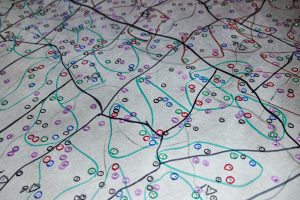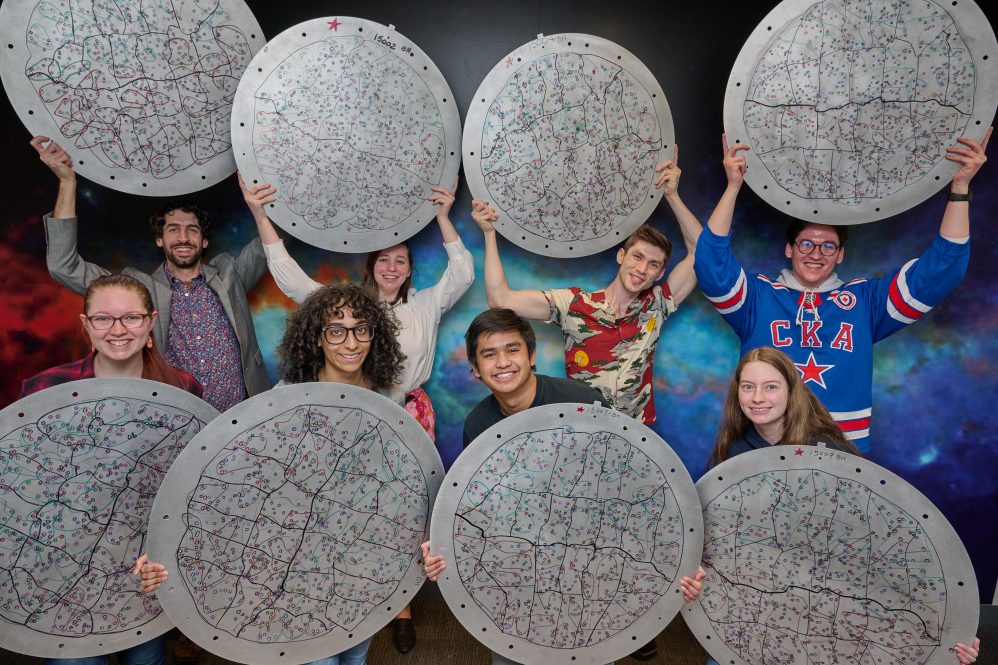UConn is now home to tools that have played an instrumental role in mapping the universe — 10 large aluminum plates used as part of the Sloan Digital Sky Survey (SDSS). Measuring 32 inches across, one-eighth of an inch thick, and with thousands of tiny holes drilled in them, these plates may not be the type of instruments most people would initially picture; however, they have helped answer important questions about the universe.
Jonathan Trump, associate professor of physics, helped design the final round of plate observations for SDSS, which observed over three million objects in the sky, including stars, galaxies, and supermassive black holes from a telescope in New Mexico.

For hundreds of years, astronomers have gathered data by studying the light emitted by celestial objects. This light can be thought of as a “chemical fingerprint” of an object, explains Trump, which can reveal distance, temperature, orbit, and age of the object under scrutiny. SDSS takes this approach for hundreds of objects at a time, using sheets of metal with tiny, precisely-positioned holes drilled in it, each hole representing a separate point of interest in the sky. Once mounted on the telescope, optical fibers are hand-placed between each hole to lead the light to a spectrograph. The data is then released for anyone to access.
“SDSS is really impressive in its multiplexing,” Trump says. “Classic spectroscopy does one object at a time, while SDSS takes spectra of several hundred objects — spread over an area that is seven times larger than the diameter of the Moon — all at once. The arrangement of holes on an SDSS plate represents a constellation on the sky, though that constellation can represent distant galaxies and black holes rather than the constellations of bright stars we see with our eyes. These aluminum plates are how SDSS has been able to map 3 million objects over most of the northern sky.”
The plates Trump helped design were gifted to UConn, and Trump has plans to use the plates in teaching and outreach, carrying on the survey’s emphasis on education and open access.
“For me, the coolest thing about having the plates at UConn is having something tactile that’s connected to my research,” he says. “I’m used to my objects of study (galaxies and distant supermassive black holes) being way too far away to ever touch, so it’s great to have a physical object that I can use to explain how astronomers map the universe.
“We’re planning to turn one of the plates into a table, with a light source underneath that illuminates the holes to demonstrate the constellation of targets mapped on the sky. We also hope to mount a plate on one of the exterior glass walls of the Astronomy Suite in Gant South so that the setting sun will shine through the pattern of holes, just as the light of distant galaxies and black holes entered the plate when it was mounted at the SDSS telescope in New Mexico.”
Trump explains that, after 20 years of plate observations, SDSS has now transitioned into a new robotic system in its “SDSS-V” iteration of the project.
“Instead of hand-plugged fibers going into these aluminum plates, we now have 500 little robots that position fibers on a grid in the sky. This offers a lot more flexibility and real-time adjustment of how we observe science targets. The survey is also taking over a second telescope in Chile, and over the next 5 years it will expand our spectroscopic map of the universe to 6 million stars, galaxies, and supermassive black holes spread over the entire sphere of the sky.”



